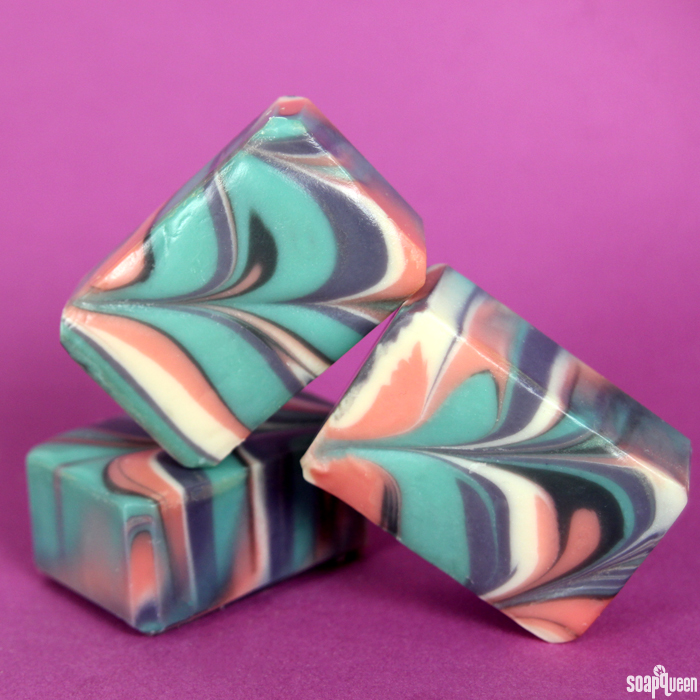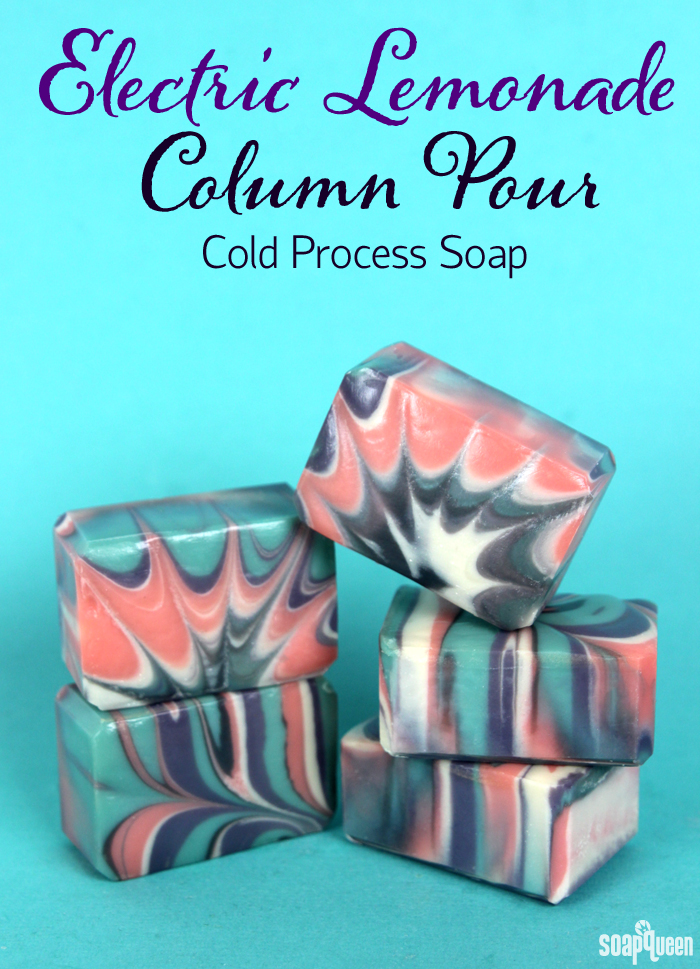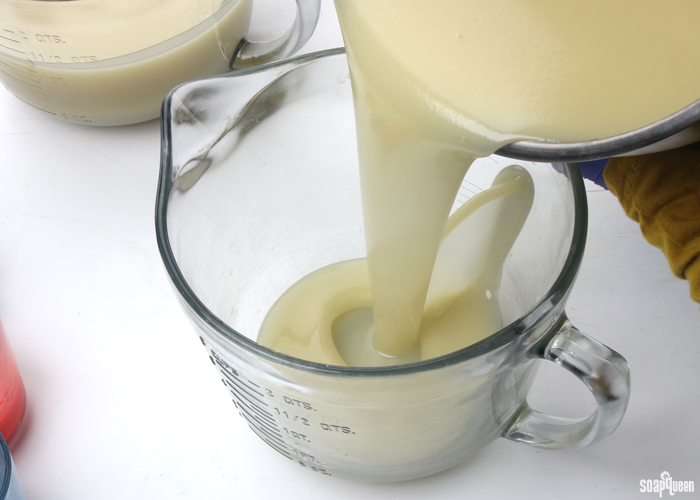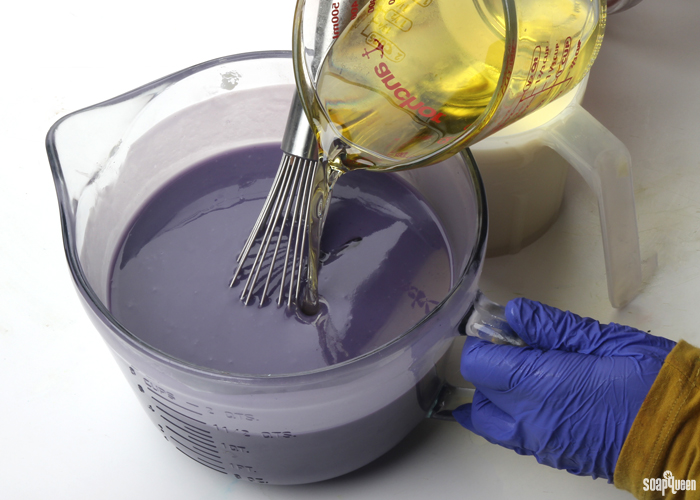What You’ll Need:
36 Bar Unfinished Birchwood Mold
131 oz. Swirl Quick Mix
18.1 oz. Sodium Hydroxide Lye
43.2 oz. Distilled Water
10 oz. Electric Lemonade Cocktail Fragrance Oil
Neon Blue Raspberry Colorant
Tangerine Wow! Colorant
Ultramarine Violet Oxide Pigment
Titanium Dioxide
Black Oxide
Optional: 2 Squeeze Bottles
If you’ve never made Cold Process soap before, check out our FREE four part SoapQueen.tv series on Cold Process Soapmaking, especially the episode on lye safety. Bramble Berry also carries a wide range of books on the topic, including Soap Crafting. You can also checkout the digital downloads.
SAFETY FIRST: Suit up for safety! That includes goggles, gloves and long sleeves. Make sure kids, pets, and other distractions and tripping hazards are out of the house or don’t have access to your soaping space. Always soap in a well-ventilated area.
COLOR PREP: To make sure the Titanium Dioxide blends smoothly into the soap, we recommend micronizing it beforehand. This is an optional step, but it does help prevent the Titanium Dioxide from clumping. To micronize the colorant, use a coffee grinder to blend the colorant to break up any clumps of color and prevent streaks of white from showing in the final soap. Then, add 3 teaspoons of each color into 3 tablespoons of sunflower or sweet almond oil. Next, add 1 teaspoon Black Oxide into 1 tablespoon of a lightweight liquid oil. Add 3 teaspoons of Neon Blue Raspberry and Tangerine Wow! Colorant into 3 tablespoons of a lightweight liquid oil in separate containers. Add 4 teaspoons of Ultramarine Violet Oxide Pigment into 4 tablespoons of a lightweight liquid oil. Use a mini mixer to smooth any clumps of color.
MOLD AND COLUMN PREP: Before you start, line your mold with freezer paper. To learn how to line a mold, click here. If you choose squeeze bottles to create the column pour design, remove the caps from them. Next, wrap the top of the squeeze bottles with tape to cover them. Large creases can affect the design of the soap, so try to make the tape as smooth and even as possible. If you don’t have squeeze bottles available, you can use any other column shape that is safe for cold process soap. Whatever size and shape you choose will affect the pattern and size of the layers. You can also weigh the bottles down, because it makes it a bit easier to pour soap over them.
ONE: Carefully and slowly add the lye to the water and stir gently until the lye has fully dissolved and the liquid is clear. Set the lye and water aside to cool.
TWO: Melt the Swirl Recipe Quick Mix fully. Pour the oils into a large container that holds 200 ounces. When the lye water and the oils have cooled to around 130 degrees or below, and are ideally within 10 degrees of each other, add the lye water to the oils. Stick blend the oil and lye until it reaches thin trace. If you’d like a firmer bar of soap that releases faster from your mold, you can add sodium lactate to the cooled lye water mixture. Use 1 teaspoon of sodium lactate per pound of oils in your recipe. In this recipe, you’d add about 8 teaspoons sodium lactate total.
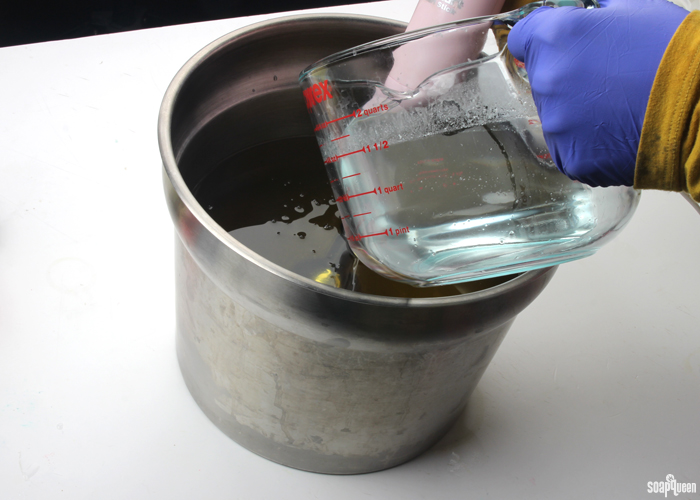

THREE: When your soap is at a thin trace, split it into three large containers. Each one should have about 5.5 cups each. Split the remaining soap into two smaller containers of about 900 mL each. In the containers, whisk in the dispersed colorants listed below.
- Container A (5.5 cups): 3 Tbs. Neon Blue Raspberry Colorant + 1 tsp. Titanium Dioxide
- Container B (5.5 cups): 3 Tbs. Tangerine Wow! Colorant
- Container C (5.5 cups): 4 Tbs. Ultramarine Violet Pigment + 1/4 tsp. Black Oxide
- Container D (900 mL): 3 Tbs. Titanium Dioxide
- Container D (900 mL): 1 tsp. Black Oxide
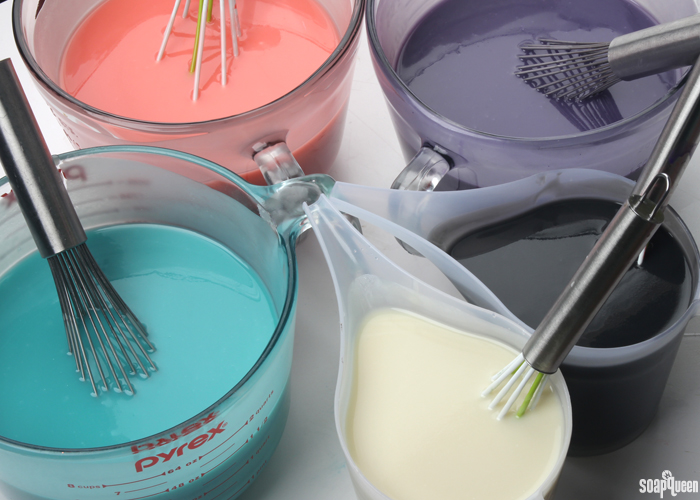
FOUR: Pour the fragrance oil evenly into each container. You can eyeball it if you like. Fully incorporate the fragrance oil using a whisk.
FIVE: Choose a color order. Make sure to stick with the order the entire time you’re making the soap. We used purple, white, orange, black and blue. Pour the first color in the middle of the squeeze bottles. Count to 3 to ensure even pours each time. Repeat this step with the other colors of soap, again counting to 3 each time. Repeat the process until you run out of soap. To keep the soap fluid and avoid graininess, whisk each color after a few pours.
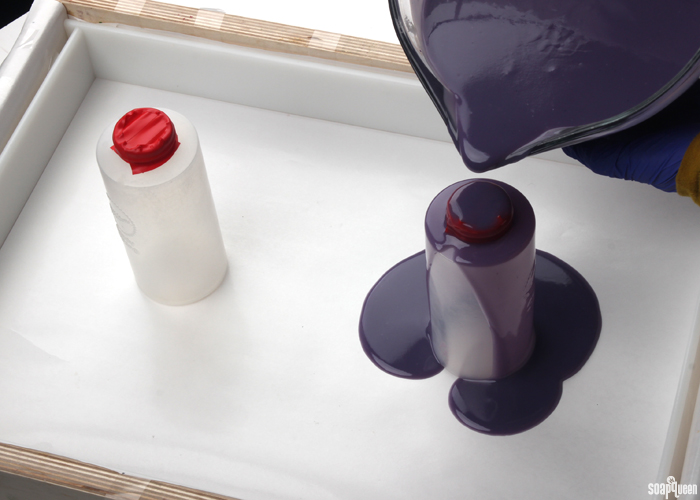

SIX: When the soap has been poured, carefully and slowly remove the bottles from the soap. It helps to have a container waiting nearby to set the bottles in, as they will be messy. Then, firmly tap the mold on the counter to help settle the soap and pop any air bubbles. The mold is very large, so you may want a helper to help you tap the mold. If you have a few drops of white soap, add a dollop in the center of the layers. This is an optional step. The white gives a nice contrast to the other colors.
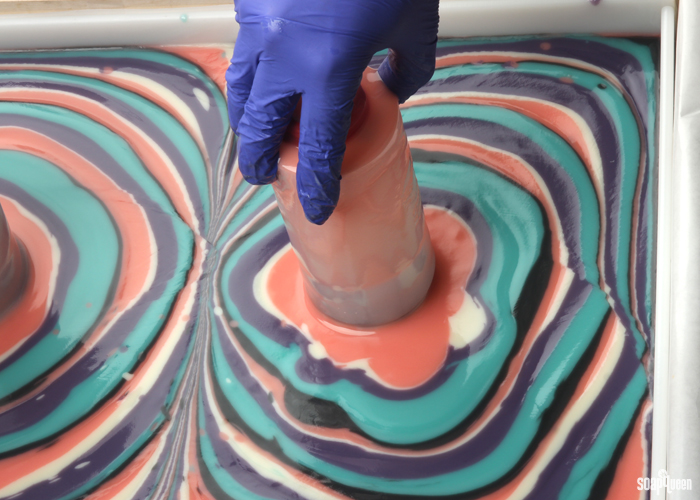 SEVEN: In the center of each column pour, insert a dowel or chopstick. Swirl the chopstick outward in a circular motion. Do not insert the dowel or chopstick all the way to the bottom of the mold, only swirl the top of the soap. When you reach the end of the circle, swirl the other circle.
SEVEN: In the center of each column pour, insert a dowel or chopstick. Swirl the chopstick outward in a circular motion. Do not insert the dowel or chopstick all the way to the bottom of the mold, only swirl the top of the soap. When you reach the end of the circle, swirl the other circle.
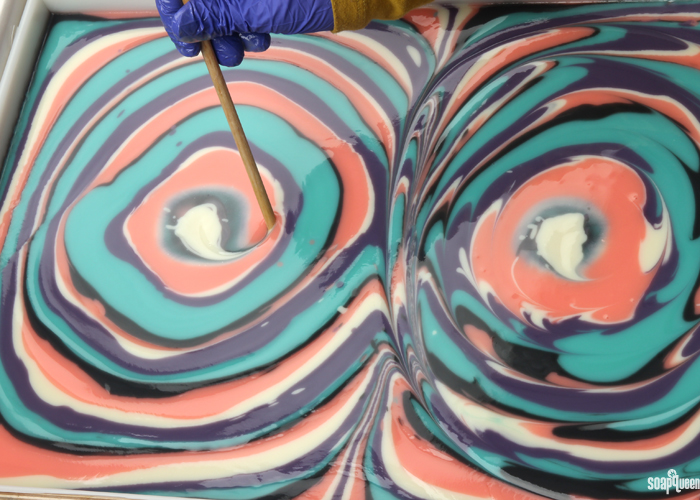 EIGHT: Clean off your swirling tool. Insert it into the center of each column pour pattern. Again, only insert the tool into the top of the soap, don’t insert it all the way through. Drag the swirling tool straight to the edges of the mold. Repeat this process for the other column pour.
EIGHT: Clean off your swirling tool. Insert it into the center of each column pour pattern. Again, only insert the tool into the top of the soap, don’t insert it all the way through. Drag the swirling tool straight to the edges of the mold. Repeat this process for the other column pour.
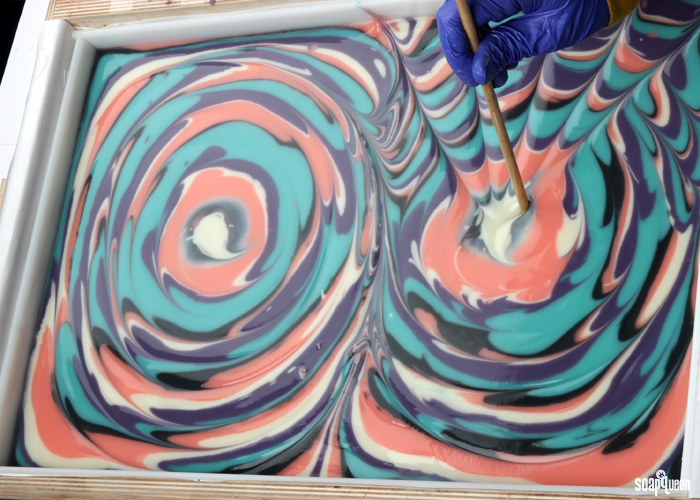
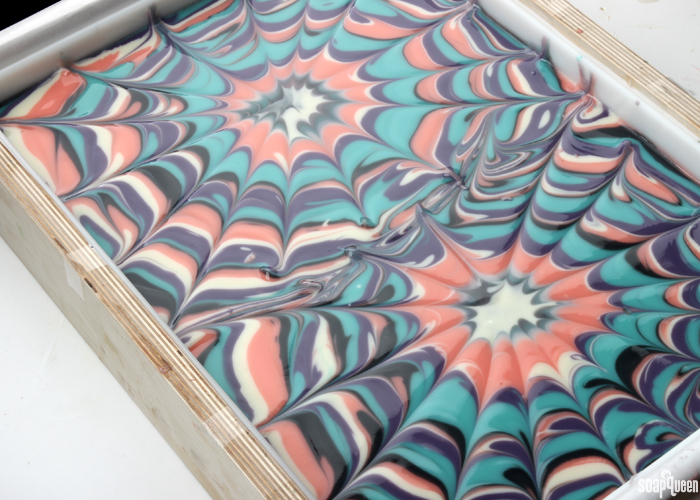 NINE (optional): Insert the 36 bar divider set. To learn how to assemble the divider sets for birchwood soap molds, click here.
NINE (optional): Insert the 36 bar divider set. To learn how to assemble the divider sets for birchwood soap molds, click here.
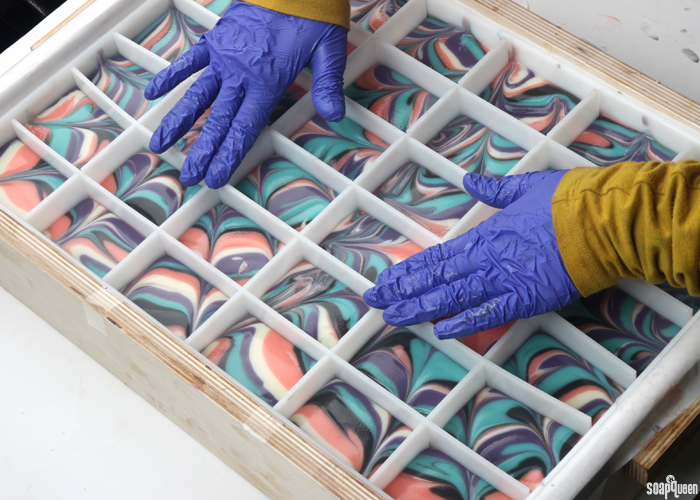 TEN: Spritz the top of the soap with 99% isopropyl alcohol to help prevent soda ash. We promoted gel phase by placing the lid on the mold and setting it on a heating pad on medium for 30 minutes. That helps the colors pop. To learn more about gel phase, click here.
TEN: Spritz the top of the soap with 99% isopropyl alcohol to help prevent soda ash. We promoted gel phase by placing the lid on the mold and setting it on a heating pad on medium for 30 minutes. That helps the colors pop. To learn more about gel phase, click here.
